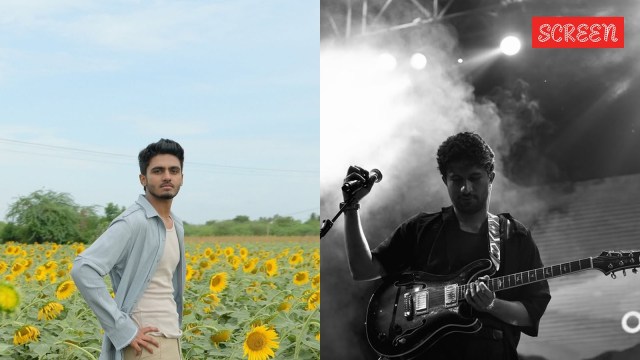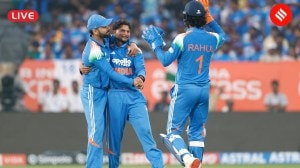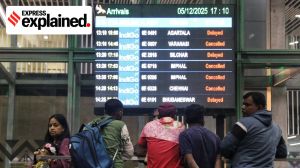Click here to follow Screen Digital on YouTube and stay updated with the latest from the world of cinema.
‘100 listeners to 8.5 mn in a year’: Spotify India exec on Bollywood music losing popularity, rise of indie-pop and artistes you need to check out now
Five years ago, almost 80% of the music being consumed was from films, which has now been reduced to 60%, with the remaining being artist-first.
 Sai Abhyankar (left) and OAFF (right) are two of the artists that were featured on RADAR. (Photo: Instagram/OAFF/Sai)
Sai Abhyankar (left) and OAFF (right) are two of the artists that were featured on RADAR. (Photo: Instagram/OAFF/Sai)Just like the movies that are adorned with them, music as a career is something that can’t be planned. You could either debut like 50 Cent and then live under the shadow of the great artist you once were, or you could push the envelope like Led Zeppelin and do better every time you enter the recording studio. Like every other career that might cross your mind while growing up in India, music too is a crowded and saturated place. You need to literally be one in a billion to be able to crack through the mediocrity of the masses in order to become what they ultimately look up to.
Spotify India Head of Music and Podcasts Dhruvank Vaidya recently sat down with SCREEN to discuss this very problem and what the streaming platform is doing to bring forth new talent. He talked extensively about the RADAR programme and how this initiative is slowly but surely proving to be one of the things that helps the overall trajectory of the independent artist.
Right off the bat, if you had to explain Spotify RADAR’s mission, how would you describe it?
India primarily used to be a very film-music-first industry, and for the longest time that was the genre that dominated. But for the last 5 years we have seen artist-first music grow a lot. Recently an EY report suggested that 5 years ago almost 80% of the music being consumed was from films, and now that has gone down to 60%, with the remaining being artist first.
We are also seeing a huge surge of young artists and musicians coming into our market. RADAR’s mission is to provide the artist the initial support they need to level up. It is a global programme, and it started here in India soon after its global inception in 2020.
So how does RADAR exactly work for the artists?
So RADAR is basically a playlist on the platform, and we have around 50-75 songs. Every month we pick one artist to feature on the cover of this playlist, which is a very big deal. Apart from featuring on the cover, we also do social media with them. While it started with just Hindi and English artists, we have also started RADAR for Tamil and Punjabi.
So the way this works is that the artists send in their music to us over our platform, and then our editors listen to it. They look at the releases of these artists that are already on the platform, and on the basis of all that, they choose the RADAR artists.
Is there some kind of remuneration involved when artists get chosen for the RADAR programme?
The RADAR programme is not about remuneration; it’s about making the artist popular. All labels keep track of our playlists, and the independent artists who feature on the RADAR playlist are often signed right after. In addition, we have seen RADAR artists become much bigger on our platform and even do film music, like OAFF (1.5 million monthly listeners) and Savera (748k monthly listeners) for Gehraiyaan. Kanishk Seth (1.5 million monthly listeners) did music for Jugjugg Jeeyo. There are a lot of examples where this has become a stepping stone to bigger and better things for the artists.
What are your thoughts on artists having to depend heavily on social media to market their music?
Let’s take film music as an example; the music gets marketed through the promotions done for the film. When an independent artist releases their own music, they have to do a lot by themselves. There are mainly two big areas that artists need to focus on. One is that they need to build their fanbase, because they are the ones that follow you and really know the inside picture of what you are doing and how you are doing it. Something like knowing the meaning behind that one word you used in your lyrics.
You have to build that base across multiple platforms, including Spotify. The other big factor is how you best leverage the tools provided to you by the streaming platform. We are inherently an artist-first platform, and tools like being able to like and follow your favourite artists. When fans add your songs to playlists, or they follow you or like your music, that tells the system that one particular user is interested in your music; hence, when you drop a new project, it reaches them first.
ALSO READ: Anu Malik can take other people’s songs, he just needs to do it like Elvis Presley
What do you think is more important for an upcoming artist: quality or volume?
Every artist has their own process of releasing music. I’ll give you an example: there is an artist from Tamil Nadu called Sai Abhyankar (8.5 million monthly listeners). We featured him on this programme in January 2024, and that was the first time he had just released his first indie track called ‘Katchi Sera’. That track broke all records, and it was the first Tamil indie track to cross 100 million.
His next track, ‘Aasa Kooda’, was the fastest song to cross that same mark. He released three indie songs last year, and all three were breakout hits, and this year he has signed 7 Tamil films as a music composer. So it depends on how you shape your creativity and how you want to communicate with your fans. It’s not about how many or how much.
What is the next step for an artist once they have been selected for the platform’s curated playlists?
We have realised that we need to support the artists throughout the arc of growth. The first step from our side is Fresh Finds, which is sort of our playlist for new artists. There we feature a new artist every week. Once they become a little bit bigger, they try for RADAR, and they get featured there. For example, 5 out of the 9 artists who were featured in 2025 were from our Fresh Finds programme.
We try to stay regularly in touch with them and track their growth. Once they become even bigger than RADAR, we have another program called I-Pop. This is where the biggest stars like King (6 million), Badhshah (17.7 million), Jonita Gandhi (16 million) and Darshan Rawal (14.6 million) have all been on the cover of this playlist. We have a distinction even there, and the artist first goes through an initial playlist called I-Pop Rising, and after becoming bigger than that, you become eligible for the next step.
The promotions suddenly become much bigger with these artists. We shoot a lot of content with them; for example, we have done long-form storytelling with Darshan and Badshah. So that is basically the growth part of the artist.
- 01
- 02
- 03
- 04
- 05


































